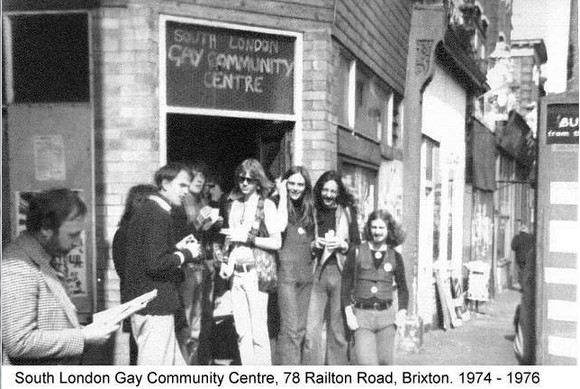
This fascinating story about Brixton’s legendary gay community of the 1970s was posted up on the urban75 bulletin boards, and thanks to the author Ian Townson, I’m now able to repost an illustrated version, giving a wonderful insight into a long lost part of Brixton life.
South London Gay Liberation by Ian Townson
The South London Gay Community Centre at 78 Railton Road, Brixton, was squatted by people who were determined to come out into the clear light of day with a public statement of gay identity.
It was the first of its kind and for two hectic years of ‘fits and starts’ the Centre established an undeniable and irreversible presence of gay people in the area.
The Centre opened in March 1974 and was evicted in April 1976.
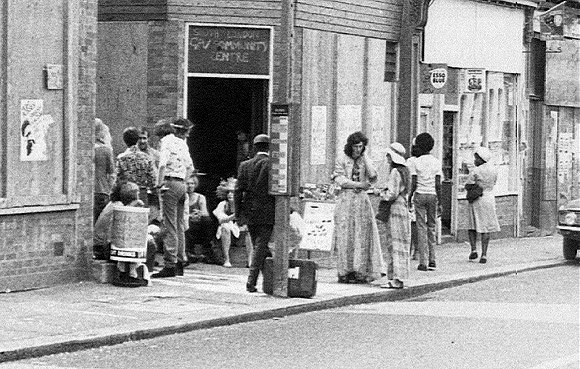
During the short period of its existence the Centre acted as a focal point bringing together gay people from many different backgrounds through social activities and political action.
The Centre also acted as a magnet attracting people into the area who squatted several back-to-back houses on Railton and Mayall Roads with a shared garden in between them.
This became the nucleus for further political activity after the closure of the Centre but equally it grew, over time, as an experiment in new communal living arrangements for gay people with varying levels of success.
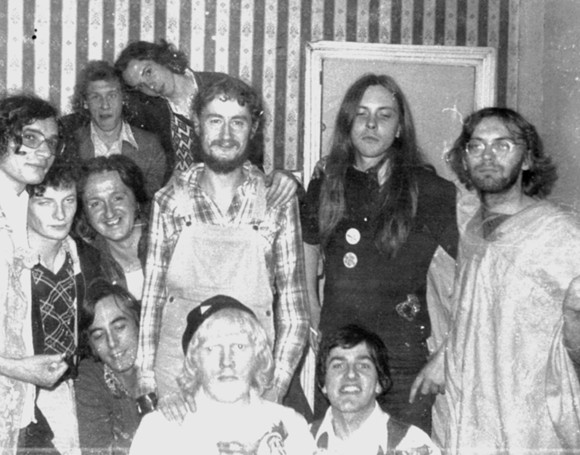
Kitchen of 152 Mayall Road. The two boys in the back row and the first on the left I think were visitors from
Germany. I don’t know their names. Second row L-R Paul ?, Malcolm Greatbanks, Edwin Henshaw, John Lloyd, Ian Townson (what was I wearing?), Stephen Gee peeping out from behind Edwin and Terry Stewart, Gerry Comey in the first row.
Gay people arrived at the squats for many different reasons. Some were desperately fleeing from oppressive situations in their lives. Others were glad to find the company of unashamedly out gay people rather than remain confused and isolated.
Some consciously saw this as an opportunity to attack ‘straight’ society through adopting an alternative lifestyle that challenged the prevailing norms of the patriarchal nuclear family and private property.
There were many visitors from overseas. Everything would be shared in common including sex partners and gender bending was encouraged to dissolve rigid categories of masculine men and feminine women. For others dressing in drag was a sheer pleasure and an opportunity for ingenious invention.
The ‘cultural desert’ in South London offered little social space in which to gather strength as ‘out’ gay people. The ‘straight’ gay scene was inhospitable, exploitative and a commercial rip off (it is now gay-owned, exploitative and a commercial rip off).
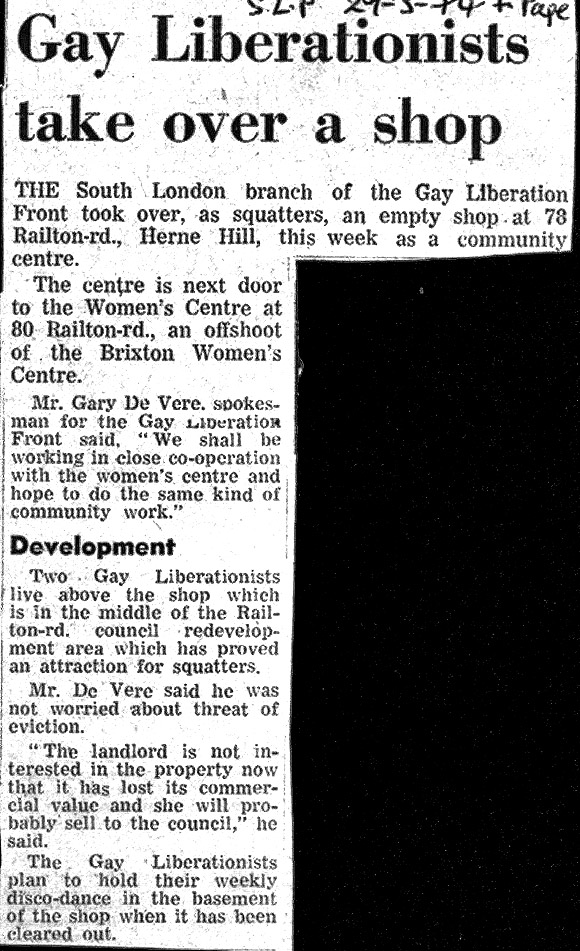
Brixton in the 1970s
Brixton was one of the most deprived inner city areas in London with high levels of unemployment and crime, a chronic shortage of housing stock with many dilapidated buildings left empty, large-scale environmental decay and blatant racism in an area with a large, young black population.
Into this cauldron of deprivation leapt a number of different groups in and around Railton Road to challenge the poverty and decay in people’s lives.
There were two women’s centres on Railton Road, an Anarchist News Service, Squatters Groups, a Claimants’ Union for those on welfare benefits, the Brixton Advice Centre, Icebreakers (a gay liberation counselling group), the Race Today Collective and a food cooperative in nearby Shakespeare Road and Atlantic Road.
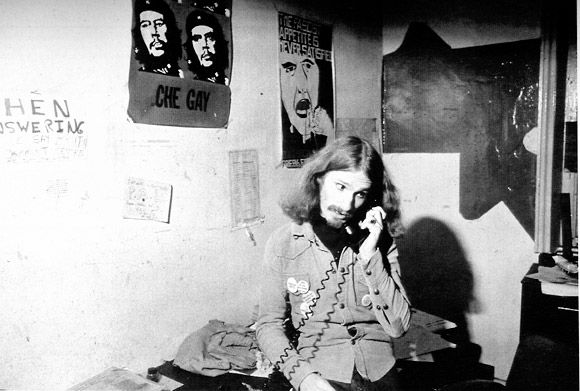
Alastair Kerr taking a call at the South London Gay Community Centre, 78 Railton Road, Brixton (mid 1970s)
The Gay Centre, as a self-determined group, also took its place among the other community based groups to challenge prejudice, discrimination, heterosexist attitudes and the complacency of officialdom.
There were many different activities at the Centre. A modern dance group was formed and run by Andreas Demetriou.
There was a wrestling group in the basement and, to counter the ‘macho’ posturing of the group, a sewing bee and knitting circle was formed in the upstairs front room run chiefly by Alistair Kerr and Malcolm Watson.
We participated in the local and general elections in 1974 with Malcolm Greatbanks, Alistair Kerr and Michael Mason as the candidates.
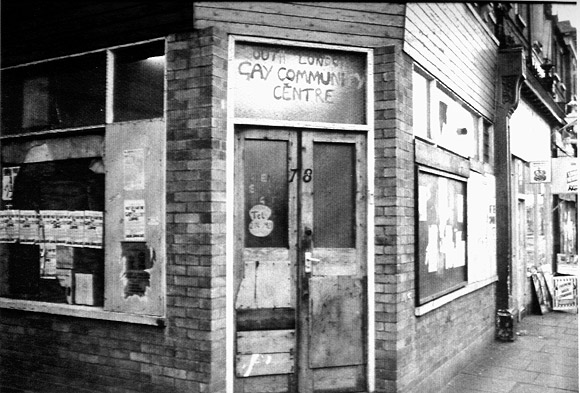
Being against Parliamentary Democracy as a meaningless sham it was pointed out that we were just doing this for the free publicity.
There were weekly discos in the basement, individual counsellors and regular meetings of the Centre ‘collective’ to determine which campaigns and social events we would support and be involved in.
Discos were also organised at Lambeth Town Hall and an open day was held for members of the public to come and meet us.
Besides all of this there was a regular duty rota so that all the people who visited the Centre would be greeted and made welcome. The 1976 Gay Pride event was also organised by Brixton Gays.
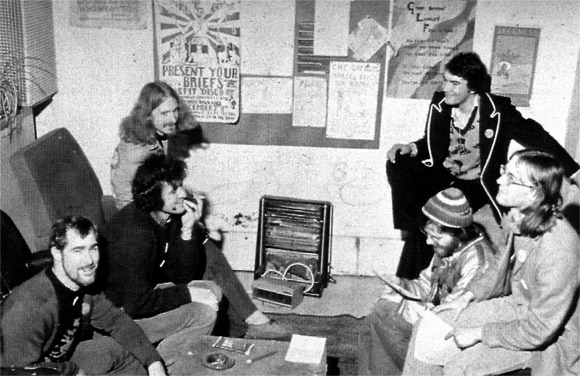
It is possible to convey some of the atmosphere of ‘communal’ living in photographs of the gay squats that sprang up around the Centre.
With a common garden between the houses the back doors were often left open so that people could come and go in and out of each others squats.
The kitchen more often than not became the hub of food, conversation and play. In the shared garden people would gather to dine Al Fresco or play music or even rehearse for various theatre productions. Even just camp it up for the hell of it.
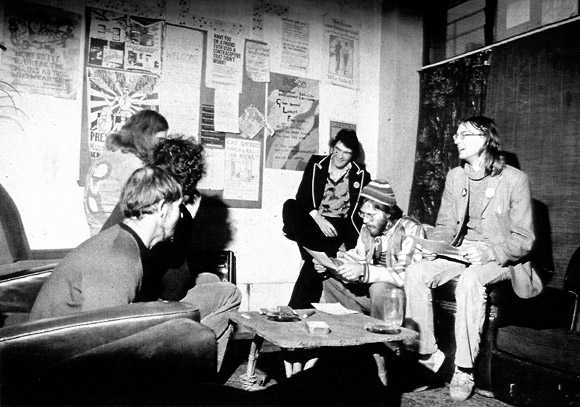
The gay squats eventually became part of the the Brixton Housing Co-op in the early 80s and were redeveloped into single person units.
While this made for more secure accommodation and the shared garden was kept in tact it led to a more ‘privatised’ existence and some of the original elan and spirit was lost as a result.
However the gay households are all still there with more or less permanent inhabitants.
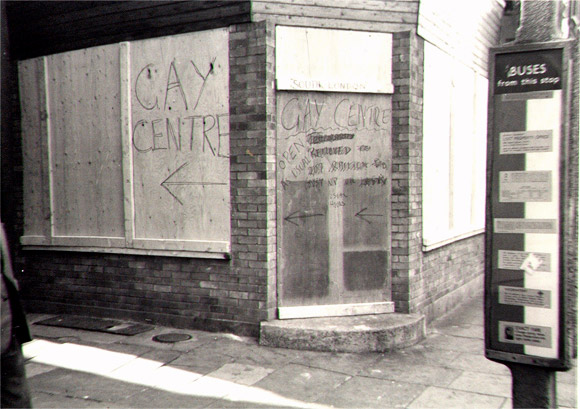
Brixton Riots
A special mention should be made of the Brixton riots of 1981 which happened chiefly as a result of the racism and heavy-handed harassment of black people by the police. The riots were centred around Railton Road and when Brixton was burning we showed our solidarity with the oppressed by joining them on the streets.
We even took tables and chairs out onto the street in front of the gay squats for a celebration party – some people in drag – getting a mixed reception from people on the steet. Some hostile, others indifferent, some amused.
Two of us were sent to prison for a couple of years for supplying petrol to the rioters.
South London Gay Liberation Theatre Group
The South London Gay Liberation Theatre Group, which later became the Brixton Faeries, produced several plays, sketches and street theatre performances. They were mostly unashamedly agit prop but later became more sophisticated with better characterisation and plotting. Beginning with a Gay Dragon paraded in a local street festival the group went on to perform sketches for local community groups.
The first play, ‘Mr Punch’s Nuclear Family’, was performed at the Centre and in a local school playground at a community event. The play attacked patriarchal values by showing the devastating effects on the wife and gay son of ‘rule by the father’ and the collusion of the male-dominated authorities in acquitting the father of murdering them (1975).
Next came ‘Out of it’ (1975/76) showing the relationship between patriarchal values, fascism and the extremes of christian morality and how they contributed to gay oppression. This was followed by ‘Minehead Revisited or The Warts that Dared to Speak their Name’.
A highly topical and controversial play at the time about the Jeremy Thorpe trial at the Old Bailey. As leader of the Liberal Party he had been accused of plotting to have a former male lover intimidated and even killed in order to keep him quiet about their affair (1977-80).
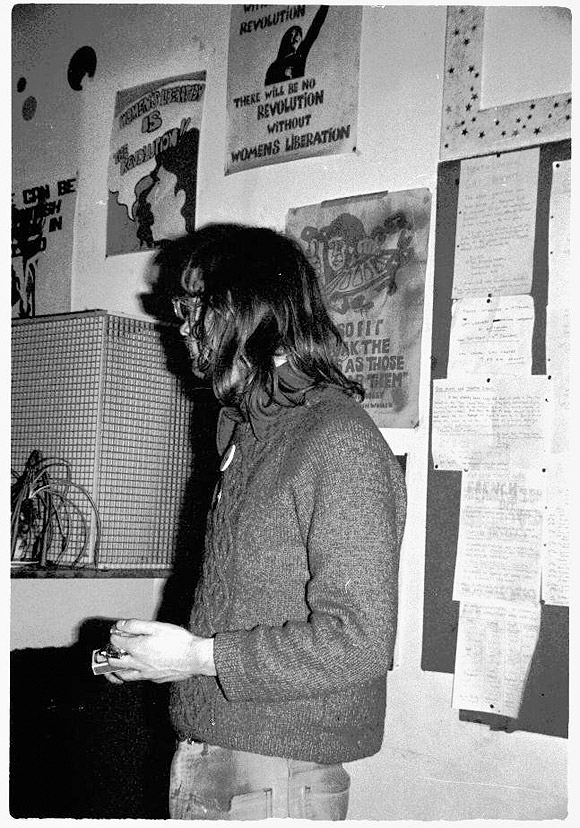
‘Tomorrow’s too Late’ was an anarchic blend of music, song and fantasy around gay activist groups and the banning of Gay News by WH Smith for carrying an advert about a paedophile group and later a poem by James Kirkup suggesting a homosexual relationship between Christ and a Roman soldier (1977-80). ‘Gents’ told the story of ‘cottaging’, that is, the reasons why men have sex with other men in public toilets.
The more respectable gays viewed cottaging as repulsive and giving ordinary, decent gay people a bad name. The police frequently arrested and charged men with ‘gross indecency’ often ruining their lives in terms of losing jobs and destroying relationships.
Brixton Faeries decided to expose the oppressive nature of police entrapment and to present cottaging in positive terms as an ideal fantasy even going so far as to suggest the local council attempting to stump up funding to ‘improve facilities’ (1978-80).
We also did Joint productions with various other groups such as Gay Sweatshop in ‘Radio Gay’ at the Oval House Community Centre.
Most of the productions were at fringe theatres or community centres and one performance of ‘Out of it’ was in front of the Young Communist League who were shocked to see two men kissing on stage.
Homophobic pubs
We picketed several pubs that we had been thrown out of in and around Railton Road for kissing and cuddling two of which, The George Hotel and The Windsor Castle, were burned to the ground during the Brixton riots in 1981. The George Hotel had previously been prosecuted under the Race Relations Act for barring black people.
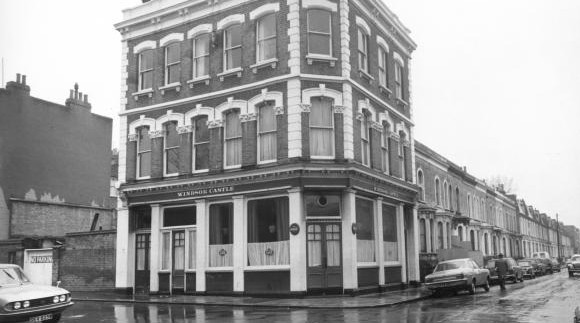
The Windsor Castle on Mayall Rd.
Queens in Furs refused to pay local rates because none of the rates were used to provide amenities for gay people. The fur coat wearing was another way of gay men challenging rigid masculine identities.
Those who refused to pay rates were summoned to Camberwell Magistrates’ Court where the presiding judge had difficulty in persuading the plaintiffs that they should ‘know their place’ and behave accordingly. Gary de Vere was thrown out for polemicsing out loud and our arguments were rejected. We lost the case as we thought we would but publicity was gained as a result.
We insisted that the Centre should be publicly funded as a right and applied to Lambeth Council for a grant rather than scraping pittance money out of our pockets for general upkeep and paying the rates. The grant was refused.
It was argued that the Centre should be privately funded despite the council granting money to other groups in the area.
Eviction
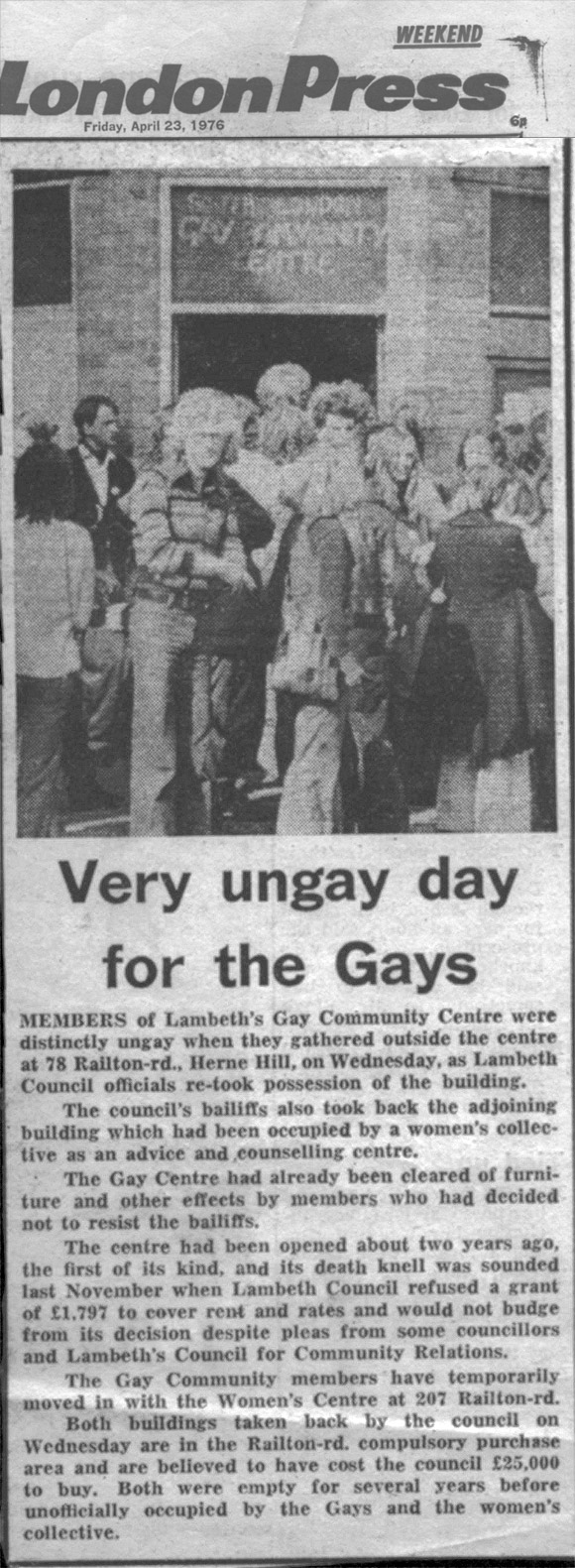
Bailiffs and police evicting the South London Gay Community Centre at 78 Railton Road, Brixton (April 1976).
The end of the centre
Many people who used the Centre were unemployed and could not afford to fund it. Infighting between different factions and lack of funding contributed to the demise of the Centre.
However the final blow came when the Centre was evicted by police and bailiffs so that the private owners could take vacant possession of the property and sell it to Lambeth Council for redevelopment.
Thus bringing to an end the first public and visible institution with a clear gay identity. With this closure the focus for political and social activity shifted from the Centre to the gay squats.
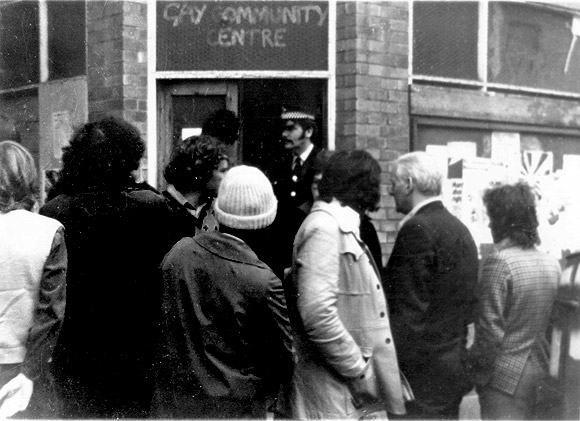
Police, workmen and bailiffs arrive to evict the South London Gay Community Centre with some gay people present to object. Jamie Hall, Colm clifford and Alistair Kerr (I think) on the left.
The National Gay News Defence Committee was originally based at 146 Mayall Road and then moved to 157 Railton Road with Stephen Gee as one of the main organisers. The group was set up when Mary Whitehouse, a right-wing moral crusader, prosecuted Gay News on a charge of blasphemous libel for carrying the already mentioned poem by James Kirkup.
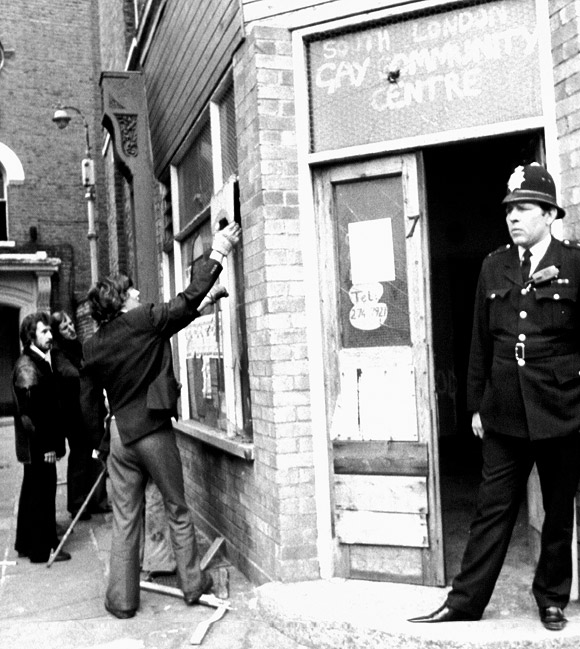
Workmen preparing to board up the Gay Centre after the eviction with a gormless looking copper standing guard. We moved back in once it had been sealed up. April 1976.
This happened at a time when there was also much police activity against gay people in different parts of the country on cottaging charges and the wrongful assumption that we were paedophiles.
With the successful prosecution of Gay News the NGNDC became the Gay Activists’ Alliance and continued with both national and international campaigns with many locally active groups.
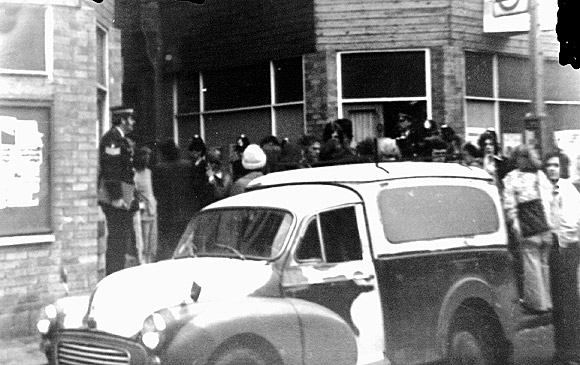
Centre being evicted
National Front
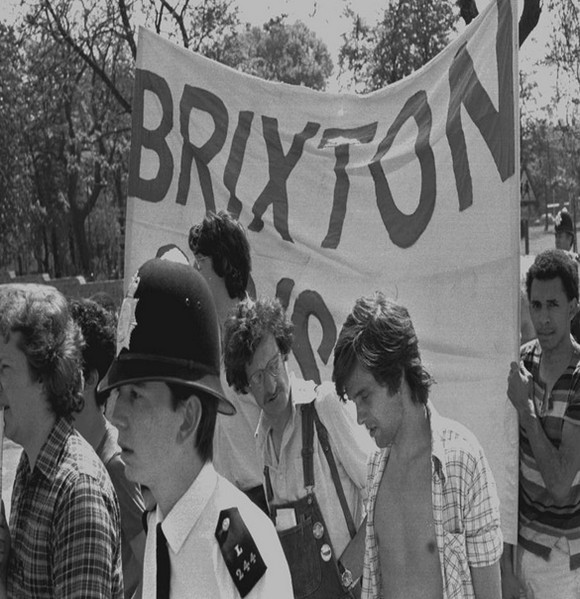
Also the fascist National Front was particularly active at this time; mostly against immigrants, black people and left-wing organisations but also several gay establishments had been attacked by them including the Vauxhall Tavern in South London.
In 1978 a massive Anti-Nazi League march came along Railton Road for a Rock Against Racism festival in Brockwell Park. We fully supported the demonstration and the marchers passed under a banner we had slung high across Railton Road saying: Brixton Gays Welcome Anti-Fascists.
Also there was Anita Bryant, the Florida Orange lady, who campaigned in the United States against gays. Her famous phrase was: ‘God made Adam and Eve not Adam and Steve’ and she became even more famous when an irate gay activist shoved a cream pie in her face in full view of television cameras.
A special mention should be made of the Union Place Community Resource Centre in Brixton which encouraged us to go along and make posters, diaries, badges, calendars and banners for our campaigns. Ian Townson and Colm Clifford from the gay community became employees and Colm initiated ‘Homosexual Posters’ from there producing pictorial biographies of gay people and even gay Christmas cards.
More info
Brixton’s radical past: when lesbians were barred from the Brady’s/Railway Hotel pub in the 1970s (Oct 2020 update)
More reading:
There’s a long running and fascinating thread our bulletin board thread – The Brixton Fairies: 1970s gay squat. Contributors include many former activists and residents.
There’s another detailed personal account from Felix Alvarez in the thread as well as an article from 1978 by Brixton Faerie, Terry Stewart and a contribution from the gay rights campaigner and BBC6 DJ, Tom Robinson.
If you have your own memories of this gay community – or any photos you’d like to share – please post them on the thread, add them here or send us a message.
(*Thanks again to Ian Townson for this article).

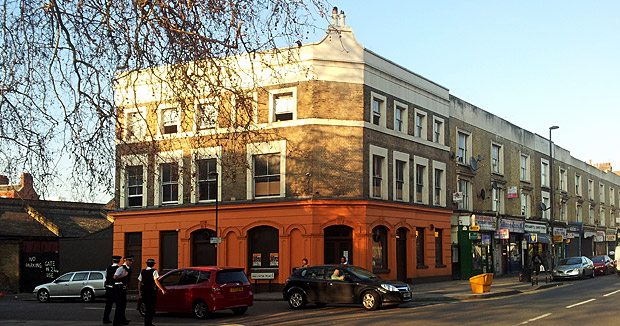
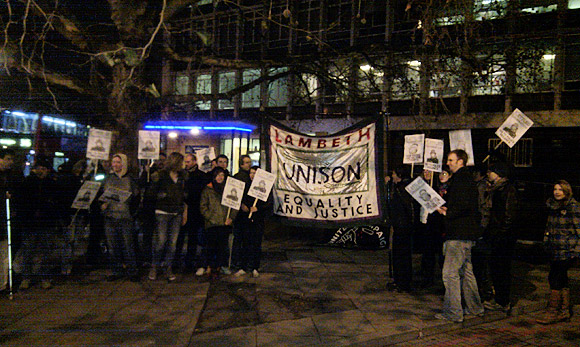
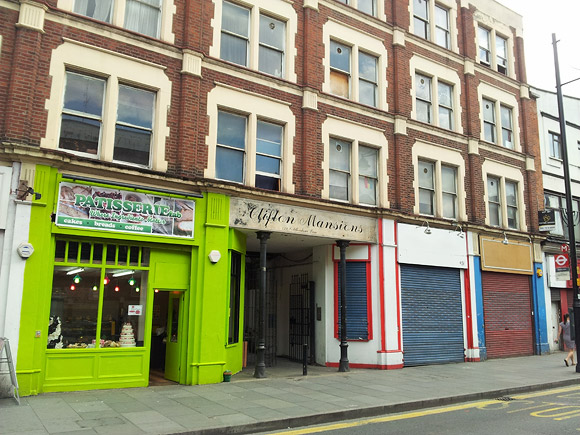
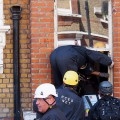
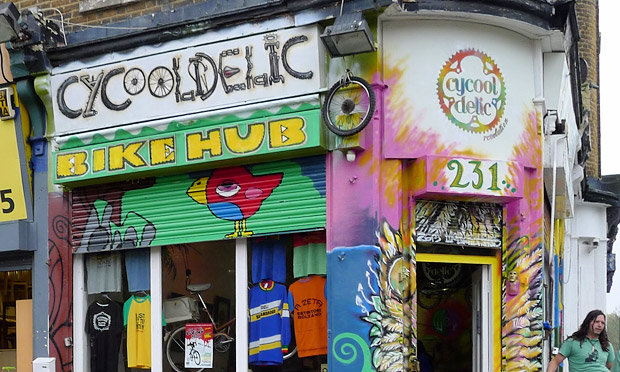
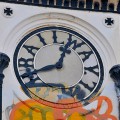
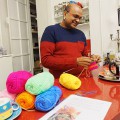
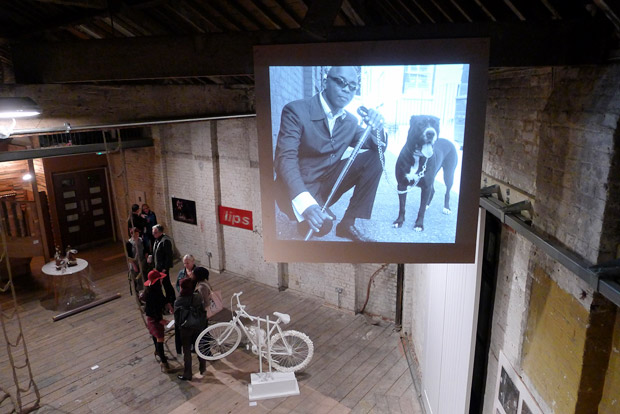
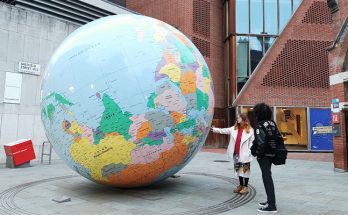
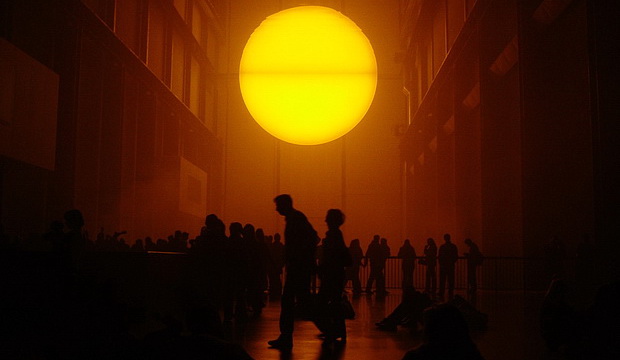
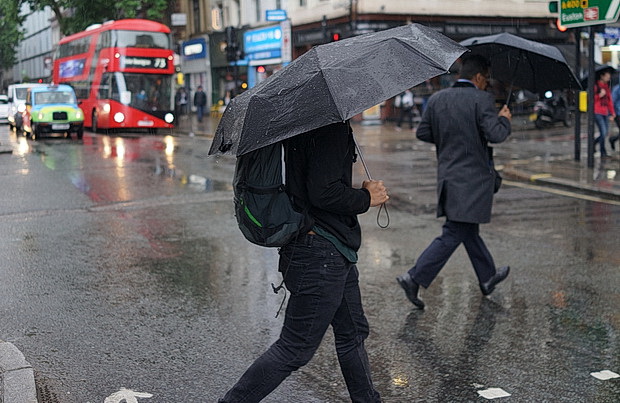
75 Comments on “The Brixton Fairies and the South London Gay Community Centre, Brixton 1974-6”